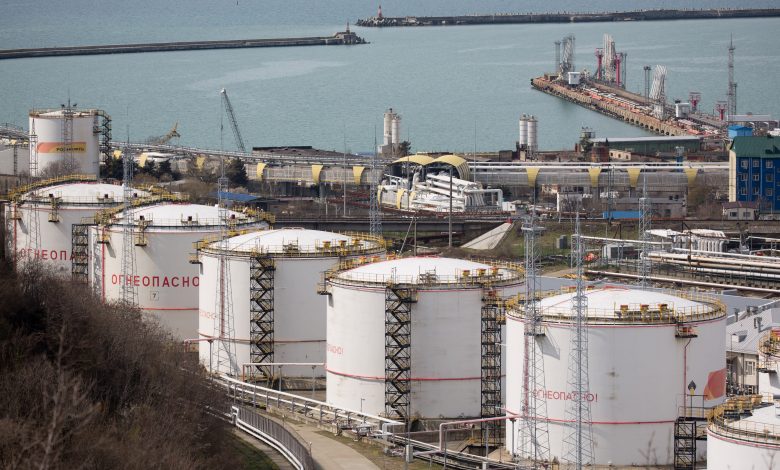Oil prices could plunge below $20 a barrel in Q2 as demand craters: CNBC survey

[ad_1]
Oil storage tanks stand at the RN-Tuapsinsky refinery, operated by Rosneft Oil Co., in Tuapse, Russia, on Monday, March 23, 2020.
Andrey Rudakov | Bloomberg | Getty Images
The oil price bust may not be over.
A historic demand shock sparked by the coronavirus pandemic is set to worsen in the current quarter, undermining any coordinated effort by heavyweight producers Saudi Arabia, Russia and the United States to cut supply aggressively and rebalance the market, according to a CNBC survey of 30 strategists, analysts and traders.
Episodic spikes of $20 a barrel or more in benchmark crude oil futures of the type seen last week cannot be ruled out as rivals Saudi Arabia and Russia attempt to reverse a damaging battle for market share and engineer a global supply deal which could cut up to 15 million barrels a day, the equivalent of about 10% of global supply.
But such price rallies are unlikely to last, according to the findings of the CNBC survey conducted over the past two weeks.
Brent crude futures, the barometer for 70% of globally trade oil, are likely to average $20 a barrel in the current quarter, according to the median forecast of 30 strategists, analysts and traders who responded to a CNBC survey, or 12 out of 30 respondents.
However, nearly a third, or nine of those surveyed, said prices may drop below $20 a barrel this quarter.
Amongst the more pessimistic projections, ANZ’s Daniel Hynes saw the risk of prices in the ‘mid-teens’ while JBC Energy’s Johannes Benigni warned that both Brent and US crude futures could ‘temporarily’ fall to around $10 a barrel.
New normal
The Organization of Petroleum Exporting Countries (OPEC), the supplier of a third of the world’s oil, and its rivals outside the group are “of pretty limited relevance in this context, as they are neither likely to be willing nor able to stem the current demand shock,” Benigni said.
Bearish forecasters said two forces would keep oil prices depressed in the second quarter — skepticism that Saudi Arabia and Russia would relent in their price war and commit to the deepest cuts in the producer group’s history (with or without participation from U.S. shale producers) and a glut in the current quarter caused by a monumental collapse in global demand as the full economic severity of the global coronavirus pandemic unfolds.
“A demand drop of 10% is the New Normal with oil,” said John Driscoll, director of JTD Energy Services in Singapore and a former oil trader whose career spans nearly 40 years.
Global commodities trader Trafigura’s chief economist Saad Rahim offered a starker prediction. Oil demand could fall by more than 30 million barrels a day in April, or around a third of the world’s daily oil consumption, Reuters reported on March 31, citing his forecasts.
And even if Saudi Arabia, its OPEC allies and major producers outside the group such as Russia and the U.S. did agree on aggressive supply restraint, it’s unlikely to materially drain global inventories that are closing in on what the oil industry calls ‘tank tops’, or storage capacity limits.
Too little, too late
“The long and short of it is that the current rally will likely be short lived,” Citigroup’s oil strategists led by Ed Morse said in an April 2 report.
“The big three oil producers may have found a way to work together to balance markets, but it looks like it is too little too late. That means prices would have to fall to the single digits to facilitate inventory fill and shut in production.”
Fatih Birol, executive director of the International Energy Agency said oil inventories would still rise by 15 million barrels a day in the second quarter even with output cuts of 10 million barrels a day, Reuters reported on April 3.
Citi expects Brent to average $17 a barrel in the current quarter and warned Moscow, Riyadh and Washington “cannot in the end stop prices from possibly falling below $10 before the end of April.”
Plus, travel restrictions, border closures, lockdowns and economic disruption caused by ‘social distancing’ and other measures taken by governments globally to slow the spread of the virus will exact a heavy toll on oil demand and could even linger when the virus clears, clouding the prospects of a recovery.
“As for the second quarter or even the third, I don’t see a V-shaped recovery for prices,” said Anthony Grisanti, founder and president of GRZ Energy, who has over 30 years of experience in the futures industry.
“The longer people are shut in the more likely behaviour will change…I have a hard time seeing oil above $30-35 a barrel over the next 6 months.”
Source link





